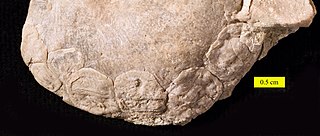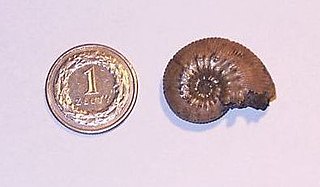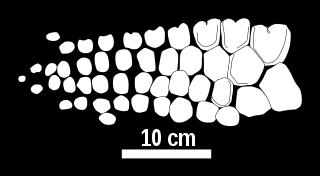
The Kimmeridge Clay is a sedimentary deposit of fossiliferous marine clay which is of Late Jurassic to lowermost Cretaceous age and occurs in southern and eastern England and in the North Sea. This rock formation is the major source rock for North Sea oil. The fossil fauna of the Kimmeridge Clay includes turtles, crocodiles, sauropods, plesiosaurs, pliosaurs and ichthyosaurs, as well as a number of invertebrate species.
Abbasites is an extinct genus of ammonites from the early Middle Jurassic epoch, included in the ammonitid family Erycitidae.

Amaltheus is an oxyconic ammonite with a fairly open umbilicus, serrated keel, and slightly sigmoidal ribs from the Lower Jurassic, many of which are strigate. Amaltheus, named by de Montfort, 1808, is indicative of the upper Pliensbachian stage in Europe, north Africa, Caucasus, Siberia, N. Alaska, Canada, Oregon, and possibly Honduras; and is the type for the Amaltheidae and a member of the Eoderoceratoidea.

Aulacostephanus is an extinct ammonoid cephalopod genus from the Upper Jurassic Tithonian belonging to the perisphinctoidean family Aulacostephanidae.
Asthenoceras is a genus of ammonoid from the Middle Jurassic with dwarfish, evolute, smooth, compressed, discoidal, strongly keeled shell. Asthenoceras belongs to the Sonniniidae and may be a subgenus of the Lower Jurassic Grammoceras.

The Craniidae are a family of brachiopods, the only surviving members of the subphylum Craniiformea. They are the only members of the order Craniida, the monotypic suborder Craniidina, and the superfamily Cranioidea; consequently, the latter two taxa are at present redundant and rarely used.There are three living genera within Craniidae: Neoancistrocrania, Novocrania, and Valdiviathyris. As adults, craniids either live freely on the ocean floor or, more commonly, cement themselves onto a hard object with all or part of the ventral valve.

Megalneusaurus is an extinct genus of large pliosaurs that lived during the Oxfordian and Kimmeridgian stages of the Late Jurassic in what is now North America. It was provisionally described as a species of Cimoliosaurus by the geologist Wilbur Clinton Knight in 1895, before being given its own genus by the same author in 1898. The only species identified to date is M. rex, known from several specimens identified in the Redwater Shale Member, within the Sundance Formation, Wyoming, United States. A specimen discovered in the Naknek Formation in southern Alaska was referred to the genus in 1994. In Ancient Greek, the generic name literally translates to "large swimming lizard", due to the measurement of the fossils of the holotype specimen.

Kosmoceras is a moderately evolute ammonite genus from the upper Callovian of Europe with a simple aperture and irregular ribbing interrupted by an irregular row of lateral tubercles. Strong ventral tubercles are separated by a smooth depression running along the rim.

Cadomites is an extinct ammonite genus from the superfamily Stephanoceratoidea that lived during the Middle Jurassic.

Chacaicosaurus is a genus of neoichthyosaurian ichthyosaur known from the Middle Jurassic of Argentina. The single known specimen of this genus was excavated from the Los Molles Formation in Neuquén Province, and is housed at the Museo Olsacher under the specimen number MOZ 5803. This specimen consists of a skull, forelimb, some vertebrae, and some additional postcranial elements. The genus was named by Marta Fernández in 1994, and contains a single species, Chacaicosaurus cayi, making it the first named distinctive ichthyosaur from the Bajocian stage. It is a medium-sized ichthyosaur with a very long snout, which bears a ridge running along each side. The forelimbs of Chacaicosaurus are small and contain four main digits.

Tatenectes is a genus of cryptoclidid plesiosaur known from the Upper Jurassic of Wyoming. Its remains were recovered from the Redwater Shale Member of the Sundance Formation, and initially described as a new species of Cimoliosaurus by Wilbur Clinton Knight in 1900. It was reassigned to Tricleidus by Maurice G. Mehl in 1912 before being given its own genus by O'Keefe and Wahl in 2003. Tatenectes laramiensis is the type and only species of Tatenectes. While the original specimen was lost, subsequent discoveries have revealed that Tatenectes was a very unusual plesiosaur. Its torso had a flattened, boxy cross-section and its gastralia exhibit pachyostosis (thickening). The total length of Tatenectes has been estimated at 2–3 meters (6.6–9.8 ft).

Acanthoceratoidea, formerly Acanthocerataceae, is a superfamily of Upper Cretaceous ammonoid cephalopods belonging to the order Ammonitida, and comprising some 10 or so families.

Arthropterygius is a widespread genus of ophthalmosaurid ichthyosaur which existed in Canada, Norway, Russia, and Argentina from the late Jurassic period and possibly to the earliest Cretaceous.

The Rhynchonellata is a class of Lower Cambrian to Recent articulate brachiopods that combines orders from within the Rhynchonelliformea with well developed pedicle attachment. Shell forms vary from those with wide hinge lines to beaked forms with virtually no hinge line and from generally smooth to strongly plicate. Most all are biconvex. Lophophores vary and include both looped and spiraled forms. Although morphologically distinct, included orders follow a consistent phylogenetic sequence.

Perisphinctoidea, formerly Perisphinctaceae, is a superfamily of Middle Jurassic (Bajocian) to Lower Cretaceous (Barremian) ammonites, commonly with evolute shells with strong ribbing that typically divides about mid flank before crossing the venter.
Haploceras is a genus of late Upper Jurassic ammonoid cephalopods and the type for the Haploceratidae, similar to Lissoceras but with a broader whorl section and small blunt lappets and a blunt rostrum; some species with feeble ventral folds on body chamber.

Kepplerites is a moderately evolute ammonite from the lower Callovian included in the Stephanoceratoidea.

Perisphinctidae is a family of Middle and Upper Jurassic discoidal ammonites in the order Ammonitida. They have a shell morphology that is mostly evolute, typically with biplicate, simple, or triplicate ribbing. Large forms have simple apertures and smooth body chambers while small forms have lappets and ribbed body chambers.
Reynesoceras is genus of ammonites that lived during the upper Pliensbachian stage of early Jurassic. It has evolved from Prodactylioceras, or Cetonoceras. Dactylioceras (Eodactylites) has probably evolved from this genus. Aveyroniceras is a name for macroconchs of this genus. Their fossils were found in Europe, northern Africa, Asia, North America and South America.

Burkesuchus is an extinct genus of basal neosuchians from the Upper Jurassic (Tithonian)-aged Toqui Formation of southern Chile. The genus is currently represented by a single species B. mallingrandensis, named and described in 2021 on the basis of the holotype and additional referred specimens. Burkesuchus mallingrandensis was noticeably small being around an estimated 70 cm in length. The cranium is dorsoventrally depressed and transversely wide posteriorly and distinguished by a posteroventrally flexed wing-like squamosal. Burkesuchus was a small carnivore likely on invertebrates animals such as insects, crustaceans and may had feed on small aquatic vertebrates like fish. B. mallingrandensis did not have the ability to feed on large prey items or tear large chunks of meat like modern day crocodiles do. The holotype SQO.PV 17700, consist of a cervical neural arch, partial neurocranium, four dorsal vertebrae, right scapula, a right coracoid, right humerus, a ulna, left ischium, distal end of the right femur, one cervical and two dorsal osteoderms. The paratype SQO.PV 17701 fossil remains consist of a nearly complete right femur, two doral vertebrae and one dorsal osteoderm. The fossils was discovered in 2014 but was described as a new genus and species on July 23, 2021.
















